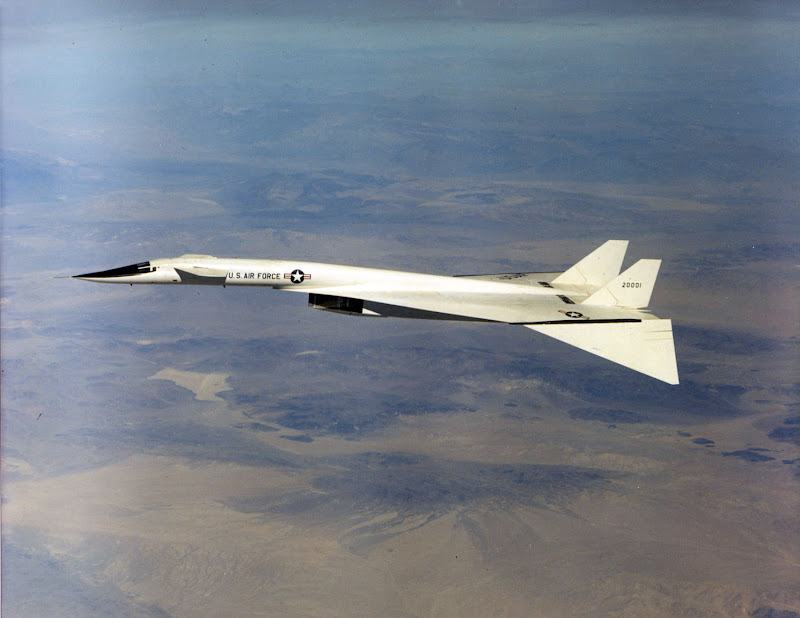The B-70 was a high-flying Mach 3 bomber, intended to replace the B-52. It was a canarded delta wing aircraft, designed to 'ride' on the shock wave contained between the lower fuselage and its movable, downturned wingtips. Because of kinetic heating at high speed, the B-70 was built from titanium and steel honeycomb parts. The advent of surface-to-aircraft missiles made the high-flying bomber obsolete. Two were built, as two-seat research aircraft.
With research and development studies beginning in 1955, the XB-70 was a large, long-range strategic bomber was planned to be the replacement for the B-52. As in the B-58 program, the Air Force wanted new technology advances. To this end, the Air Force gave the prime contractor total weapon system responsibility. Competition between Boeing and North American for the contract occurred during the design phase. In 1958, the North American design was chosen and a development contract awarded. The Air Force requirement was for a Mach 3, high-altitude, long-range bomber capable of carrying nuclear and conventional weapons. Although there was a technology breakthrough in 1957 that made Mach 3 possible, the XB-70 never went into production. The continuing emergence of new SAMs was the key factor in the demise of the XB-70, just as it affected the B-47 and B-58.
The XB-70 had a length of 196 feet, a height at the tail of 31 feet, and an estimated maximum gross weight of 521,000 pounds. It had a crew of four: pilot, copilot, bombardier, and defensive systems operator. The delta wing had a span of 105 feet with six turbojet engines side by side in a large pod underneath the fuselage. The wing was swept at about 65½ °, and the wing tips were folded down hydraulically 25o to 65o to improve stability at the aircraft's supersonic speeds of up to Mach 3. At this speed the Valkyrie was designed to ride its own shock wave. A large canard foreplane near the front of the fuselage with a span of 28 feet, 10 inches was used for stability. In addition to its sharply swept delta wings, the XB-70s had two large vertical tails. The aircraft was fabricated using titanium and brazed stainless steel "honeycomb" materials to withstand the heating during the sustained high Mach number portions of the flights. The propulsion system consisted of six General Electric turbojet engines (J93-GE 3) with two large rectangular inlet ducts providing two-dimensional airflow.
The entire mission (including return) was to be flown at Mach 3, but even then the aircraft was vulnerable to SAMs of the 1960's vintage. A high altitude, Mach 3 penetrator cannot maneuver well; its straight and level trajectory would have been an easy course to plot and intercept. Further, the technology that made Mach 3 possible yielded an airframe with a large RCS that added to the effectiveness of SAMs against the XB-70. The airframe was not adaptable to low level penetration to avoid SAMs because the delta wings were very thin and did not lend themselves to the structural modifications necessary for sustained, low level flight.
Source : www.fighter-planes.com
With research and development studies beginning in 1955, the XB-70 was a large, long-range strategic bomber was planned to be the replacement for the B-52. As in the B-58 program, the Air Force wanted new technology advances. To this end, the Air Force gave the prime contractor total weapon system responsibility. Competition between Boeing and North American for the contract occurred during the design phase. In 1958, the North American design was chosen and a development contract awarded. The Air Force requirement was for a Mach 3, high-altitude, long-range bomber capable of carrying nuclear and conventional weapons. Although there was a technology breakthrough in 1957 that made Mach 3 possible, the XB-70 never went into production. The continuing emergence of new SAMs was the key factor in the demise of the XB-70, just as it affected the B-47 and B-58.
The XB-70 had a length of 196 feet, a height at the tail of 31 feet, and an estimated maximum gross weight of 521,000 pounds. It had a crew of four: pilot, copilot, bombardier, and defensive systems operator. The delta wing had a span of 105 feet with six turbojet engines side by side in a large pod underneath the fuselage. The wing was swept at about 65½ °, and the wing tips were folded down hydraulically 25o to 65o to improve stability at the aircraft's supersonic speeds of up to Mach 3. At this speed the Valkyrie was designed to ride its own shock wave. A large canard foreplane near the front of the fuselage with a span of 28 feet, 10 inches was used for stability. In addition to its sharply swept delta wings, the XB-70s had two large vertical tails. The aircraft was fabricated using titanium and brazed stainless steel "honeycomb" materials to withstand the heating during the sustained high Mach number portions of the flights. The propulsion system consisted of six General Electric turbojet engines (J93-GE 3) with two large rectangular inlet ducts providing two-dimensional airflow.
The entire mission (including return) was to be flown at Mach 3, but even then the aircraft was vulnerable to SAMs of the 1960's vintage. A high altitude, Mach 3 penetrator cannot maneuver well; its straight and level trajectory would have been an easy course to plot and intercept. Further, the technology that made Mach 3 possible yielded an airframe with a large RCS that added to the effectiveness of SAMs against the XB-70. The airframe was not adaptable to low level penetration to avoid SAMs because the delta wings were very thin and did not lend themselves to the structural modifications necessary for sustained, low level flight.
Source : www.fighter-planes.com











